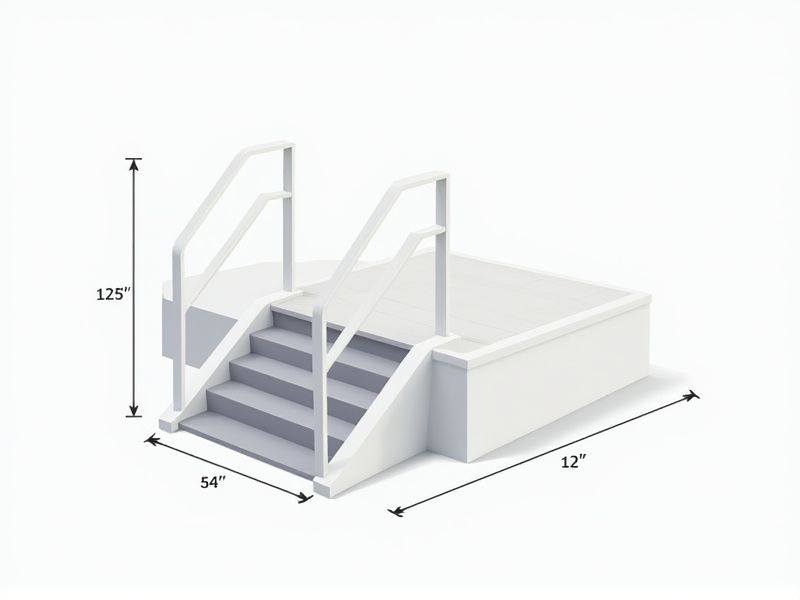
When constructing a wheelchair ramp, it's important to follow standard dimensions to ensure safety and accessibility. According to ADA (Americans with Disabilities Act) guidelines, the recommended slope is 1:12, meaning for every 1 inch of rise, the ramp should be at least 12 inches long. The width should be a minimum of 36 inches between the handrails to accommodate most wheelchairs comfortably. Additionally, landings at the top and bottom should be at least 60 inches long to allow for maneuvering and turning.
Slope Ratio
The ideal slope ratio for a wheelchair ramp is 1:12, meaning for every inch of vertical rise, there should be at least 12 inches of ramp run. This standard ensures accessibility in compliance with guidelines such as the Americans with Disabilities Act (ADA). For example, a vertical rise of 24 inches should correspond to a ramp length of at least 24 feet. Adhering to these specifications is crucial for ensuring safety and ease of use for individuals with mobility impairments.
Maximum Rise
The standard for wheelchair ramps specifies a maximum rise of 1 inch for every 12 inches of run, translating to a gradient of 1:12. This guideline ensures that ramps remain accessible and manageable for individuals with mobility impairments, supporting their independence and safety. According to the Americans with Disabilities Act (ADA), the maximum vertical rise for any single run should not exceed 30 inches. You should also consider surface materials that provide adequate traction to prevent slips, especially in wet conditions.
Minimum Width
The minimum width for wheelchair ramps is typically set at 36 inches (91.4 cm) to ensure accessibility for individuals using wheelchairs and mobility devices. This width accommodates various wheelchair sizes and allows for comfortable navigation, particularly in public spaces. Moreover, ramps should have a slope ratio of 1:12; for every inch of vertical rise, there should be at least 12 inches (30.5 cm) of ramp run. Adhering to these standards enhances safety and usability, promoting inclusivity in design.
Landings
Wheelchair ramp standards emphasize the critical role of landings, which must be flat and stable areas located at both the top and bottom of the ramp. The Americans with Disabilities Act (ADA) mandates that landing dimensions should be at least 60 inches by 60 inches to ensure sufficient space for maneuverability. Landings must be constructed with non-slip surfaces to enhance safety, particularly in wet conditions. Regular maintenance and inspection are essential to keep landings free from obstructions, ensuring optimal accessibility for users.
Handrails
The standard for wheelchair ramp handrails emphasizes a height range of 34 to 38 inches above the ramp surface, ensuring safety and accessibility for users. Handrails should extend at least 12 inches beyond the top and bottom of the ramp to provide support during transitions. A diameter of 1.25 to 2 inches is ideal for gripping, while the handrails' surface should be free of sharp edges. For your safety, ensuring that handrails are continuous, smooth, and installed on both sides of the ramp is crucial for effective use.
Surface Texture
The surface texture of wheelchair ramps is critical for ensuring safety and accessibility, with the Americans with Disabilities Act (ADA) recommending a slip-resistant finish. A textured surface can significantly reduce the risk of slipping, especially in wet conditions, making it vital for outdoor ramps used by individuals with mobility impairments. Research shows that ramps should have a slope ratio not steeper than 1:12, ensuring that the surface texture complements the incline to provide optimal traction. Regular maintenance is essential, as wear and tear can affect the ramp's surface, potentially compromising user safety.
Edge Protection
Edge protection is a crucial element in wheelchair ramp design, ensuring safety and usability for individuals with mobility challenges. The Americans with Disabilities Act (ADA) specifies that ramps should have edge protection measures such as curbs, railings, or other barriers, typically 2 inches in height to prevent wheelchair users from accidentally rolling off the side. Ramps must meet a maximum slope of 1:12, meaning for every inch of vertical rise, there should be at least 12 inches of ramp run, enhancing stability and security. Proper edge protection combined with the right slope not only complies with accessibility standards but also provides peace of mind for users navigating these essential structures.
Cross Slope
The standard slope for wheelchair ramps emphasizes a maximum cross slope of 1:48, ensuring a gradual incline for safety and accessibility. This means that for every 48 units of horizontal distance, there should only be a 1 unit rise, facilitating easier navigation for individuals using wheelchairs. Proper cross slope minimizes the risk of tipping and enhances stability, making it crucial for compliance with accessibility guidelines like the ADA (Americans with Disabilities Act). When designing or assessing a ramp, ensure your measurements meet this standard to provide a safe environment for all users.
Drainage
The standard for wheelchair ramps emphasizes proper drainage to ensure safety and accessibility. Ramps should ideally have a slope ratio of 1:12, providing optimal ease for users while preventing water accumulation. Incorporating a minimum drainage slope of 1% directs water away from the ramp surface, reducing the risk of slips and falls. Appropriate surface materials, such as textured non-slip surfaces, can further enhance grip, promoting a safer experience for individuals with mobility challenges.
Turning Radius
The recommended turning radius for wheelchair ramps is typically 60 inches (152 cm) to ensure accessibility for individuals using mobility devices. This radius accommodates smooth turns without requiring users to reposition their wheelchair excessively. Compliance with ADA (Americans with Disabilities Act) guidelines is crucial, as these standards dictate that ramps must provide a safe and functional experience for users. Ensuring the proper turning radius not only enhances usability but also helps prevent accidents or injuries during navigation.
